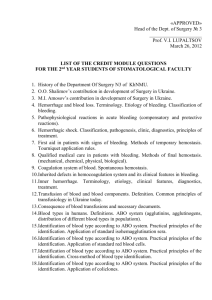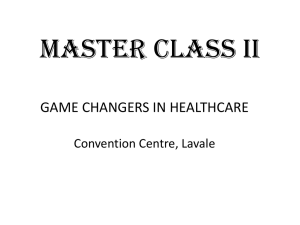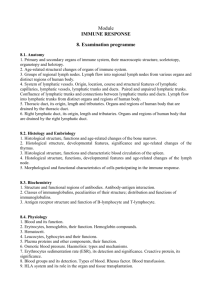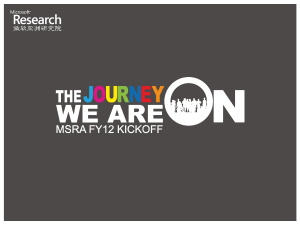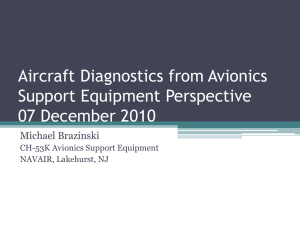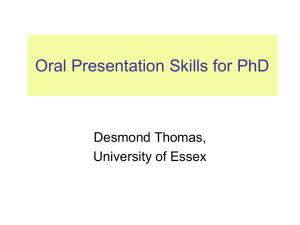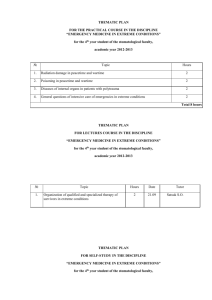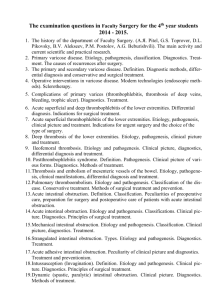exam_quest
advertisement
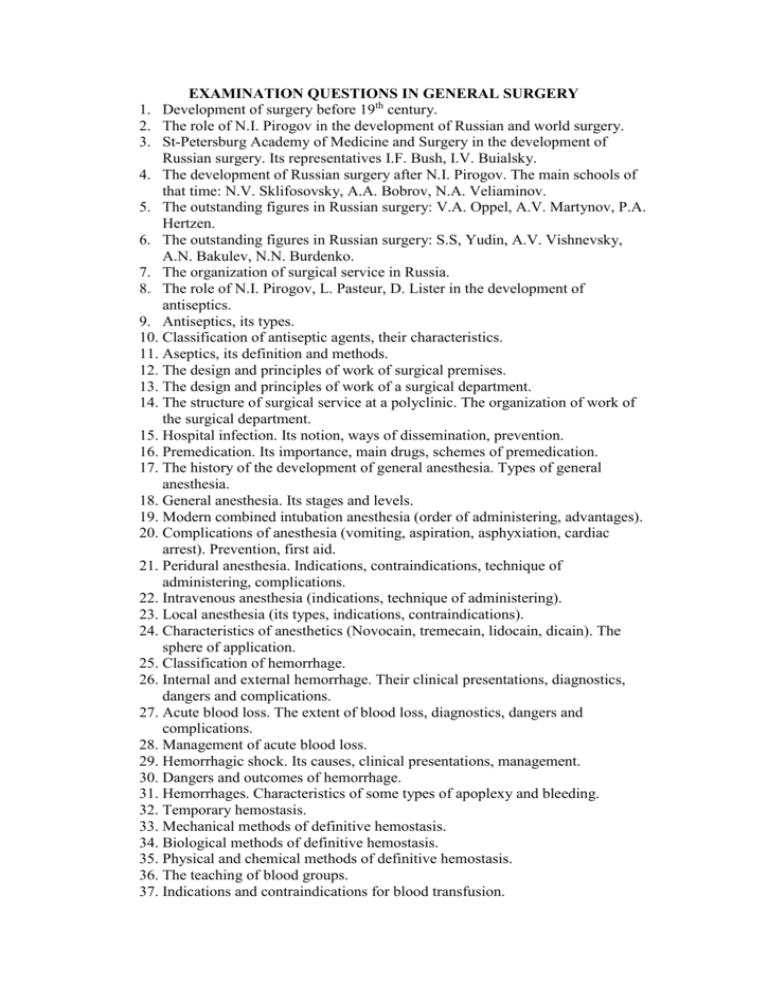
EXAMINATION QUESTIONS IN GENERAL SURGERY 1. Development of surgery before 19th century. 2. The role of N.I. Pirogov in the development of Russian and world surgery. 3. St-Petersburg Academy of Medicine and Surgery in the development of Russian surgery. Its representatives I.F. Bush, I.V. Buialsky. 4. The development of Russian surgery after N.I. Pirogov. The main schools of that time: N.V. Sklifosovsky, A.A. Bobrov, N.A. Veliaminov. 5. The outstanding figures in Russian surgery: V.A. Oppel, A.V. Martynov, P.A. Hertzen. 6. The outstanding figures in Russian surgery: S.S, Yudin, A.V. Vishnevsky, A.N. Bakulev, N.N. Burdenko. 7. The organization of surgical service in Russia. 8. The role of N.I. Pirogov, L. Pasteur, D. Lister in the development of antiseptics. 9. Antiseptics, its types. 10. Classification of antiseptic agents, their characteristics. 11. Aseptics, its definition and methods. 12. The design and principles of work of surgical premises. 13. The design and principles of work of a surgical department. 14. The structure of surgical service at a polyclinic. The organization of work of the surgical department. 15. Hospital infection. Its notion, ways of dissemination, prevention. 16. Premedication. Its importance, main drugs, schemes of premedication. 17. The history of the development of general anesthesia. Types of general anesthesia. 18. General anesthesia. Its stages and levels. 19. Modern combined intubation anesthesia (order of administering, advantages). 20. Complications of anesthesia (vomiting, aspiration, asphyxiation, cardiac arrest). Prevention, first aid. 21. Peridural anesthesia. Indications, contraindications, technique of administering, complications. 22. Intravenous anesthesia (indications, technique of administering). 23. Local anesthesia (its types, indications, contraindications). 24. Characteristics of anesthetics (Novocain, tremecain, lidocain, dicain). The sphere of application. 25. Classification of hemorrhage. 26. Internal and external hemorrhage. Their clinical presentations, diagnostics, dangers and complications. 27. Acute blood loss. The extent of blood loss, diagnostics, dangers and complications. 28. Management of acute blood loss. 29. Hemorrhagic shock. Its causes, clinical presentations, management. 30. Dangers and outcomes of hemorrhage. 31. Hemorrhages. Characteristics of some types of apoplexy and bleeding. 32. Temporary hemostasis. 33. Mechanical methods of definitive hemostasis. 34. Biological methods of definitive hemostasis. 35. Physical and chemical methods of definitive hemostasis. 36. The teaching of blood groups. 37. Indications and contraindications for blood transfusion. 38. Blood substitutes and blood products. Classification of indications for administration. 39. Preservation and conservation of blood. Determining the suitability of blood for transfusion. 40. Blood transfusion. Its method and technique. Matching of blood. 41. The mechanism of action of the transfused blood. 42. Errors, reactions and complications of blood transfusion. 43. Hemotransfusion shock. Its etiology, pathogenesis, diagnostics and management. 44. Massive hemotransfusion syndrome. Citrate and potassium intoxication. Homologous blood syndrome. Its etiology, pathogenesis, prevention and management. 45. Classification of surgical operations. Components of a surgical operation. Control of the patient’s condition during surgery. 46. Stages, aims and objectives of the postoperative period. 47. The notion of anesthesiological and surgical risk. The rules of obtaining the patient’s consent or refusal. 48. Classification and characteristics of postoperative complications. 49. Shock in surgery (posthemorrhagic, traumatic). Its etiology, pathogenesis, principles of management. 50. Coma. Acute renal-hepatic insufficiency. Its notion, etiology, principles of management. 51. Classification of surgical infection. 52. Local and general reaction of the body to pyogenic surgical infection. 53. The main principles of managing acute surgical infection. Indications for surgical treatment. 54. The notion of sepsis. Modern terminology, classification, etiopathogenesis, principles of diagnostics. 55. Principles of managing sepsis, septic shock, polyorganic insufficiency. 56. Furuncle and furunculosis. Its clinical presentations, diagnostics and management. 57. Carbuncle. Its clinical presentations, diagnostics and management. 58. Abscess, phlegmon. Its clinical presentations, diagnostics and management. 59. Hidradenitis. Its clinical presentations, diagnostics and management. 60. Erysipelas. Its classification, clinical presentations, diagnostics and management. 61. Lymphangitis. Its clinical presentations, diagnostics and management. 62. Thrombophlebitis. Its clinical presentations, diagnostics and management. 63. Mastitis. Its clinical presentations, diagnostics and management. 64. Panaritium. Its clinical presentations, diagnostics and management. 65. Wrist phlegmon. Its clinical presentations, diagnostics and management. 66. Acute hematogenous osteomyelitis. Its definition, classification, etiology, pathogenesis. 67. Acute hematogenous osteomyelitis. Its clinical presentations, diagnostics and management. 68. Osteomyelitis. Its classification, etiology, pathogenesis. Comparative characteristics. 69. Primary chronic types of osteomyelitis (Brodie’s, Ollier’s and Garre’s abscess). 70. Anaerobic infection. Its classification, etiology, pathogenesis. 71. Anaerobic infection. Its clinical presentations, diagnostics and management. 72. Tetanus. Its classification, etiology, pathogenesis. 73. Tetanus. Its clinical presentations, diagnostics and management. 74. Prevention of tetanus. 75. Endotoxicosis. Its notion, etiology, pathogenesis, methods of diagnostics, management. 76. Pneumothorax. Its etiology, clinical presentations and management. 77. Abdominal injuries. Their classification. Characteristics of open and closed injuries. 78. Abdominal injuries. Diagnostics, special investigation methods. 79. Abdominal injuries. The extent of surgical intervention according to the nature of injury. 80. Abdominal injuries. Postoperative management. Principles of intensive therapy. 81. Chest trauma. Its classification; characteristics of open and closed injuries. 82. Chest trauma. Diagnostics. First aid. 83. Chest trauma and its consequences. Principles of management. 84. The notion of fluid media and osmolarity of biological fluids in the human body. 85. Mechanism of maintaining intracellular and extracellular fluid volume and ion composition. 86. Loss of fluid; the pathological transfer of fluid in the body. Control of water and electrolyte balance. 87. Disorder of water exchange. Dehydration and hyperhydration. Their types, causes, clinical presentations, diagnostics and management. 88. Pathology of the exchange of sodium and potassium in the body. Its causes, methods of management. 89. The notion of acid-base balance as a component of homeostasis. Buffer systems of the body. Physiological systems regulating acid-base balance. 90. Management of water-electrolyte disorders. The notion of infusion therapy. The choice of an infusion therapy method. Indications for administration, possible complications. 91. Fractures. Their classification, etiology, pathogenesis. Regeneration of fractures. 92. Fractures. Their clinical presentations, diagnostics, first aid. 93. Fractures. Management of fractures of long tubular bones. Skeletal traction. 94. Fractures. Management of fractures of long tubular bones. Osteosynthesis. 95. Fractures. Management with the help of plaster casts. 96. Pathological fractures. Their etiology, peculiarities of their course. 97. Fractures. Complications in treatment of fractures. 98. Closed injuries of soft tissues (contusion, strain). 99. Wounds. Classification of wounds and their characteristics. 100. Suppurating wound. Stages of wound process. Regeneration. 101. Clean wound. Stages of wound process. Types of wound healing. 102. First aid for wounds. Primary surgical debridement of wounds. The tactics and methods of primary surgical debridement. Types of stitches (according to the time of their placing). 103. Management of wounds. Management of a suppurating wound according to the stage of wound process. 104. Burns. Thermal burns. Determining the area and depth of a burn. Determining the severity of a burn (Frank’s index). 105. Thermal burns. Their clinical presentations, diagnostics, first aid. 106. Thermal burns. Burn disease. The stages of burn disease. Management of a burn shock. First aid. 107. Electric burns. The peculiarities of clinical course and treatment. 108. Burn disease. Burn toxemia. Management of burn disease. 109. Management of thermal burns (first aid, local therapy of the burn). 110. Frostbite. Its definition, classification, periods of clinical course. First aid. Management of frostbite. 111. Benign and malignant tumours. Nomenclature, classification of tumours according to the TNM system. 112. General principles of management of tumours. Oncological awareness. 113. Necrosis. Dry and wet gangrene. Causes if its development, peculiarities of its course. Management. 114. Trophic ulcers. Their etiology, clinical presentations and management. 115. Thrombosis and embolism. Their etiology, pathogenesis and clinical presentations. Principles of management. 116. Obliterating disease of peripheral arteries. Its etiology, pathogenesis, classification. 117. Obliterating disease of peripheral arteries. Principles of diagnostics. Symptoms of plantar and palmar ischemia. 118. Principles of managing obliterating disease of peripheral arteries. 119. Chronic venous insufficiency of lower extremities. Its etiology, pathogenesis. 120. Chronic venous insufficiency of lower extremities. The principles of its diagnostics. 121. Chronic venous insufficiency of lower extremities. The main principles of management. 122. Prevention of thrombosis in patients in the early postoperative period. 123. Disseminated intravascular coagulation syndrome in surgical patients. Means of prevention, basic principles of managing the disseminated intravascular coagulation syndrome. 124. Fistulas. Their classification, clinical presentations, diagnostics and management. 125. Echinococcosis of liver. Its etiology, pathogenesis, clinical presentations and management. 126. Echinococcosis of lungs. Its etiology, pathogenesis, clinical presentations and management. Head of the chair for General surgery Prof. A.A. Poliantsev



